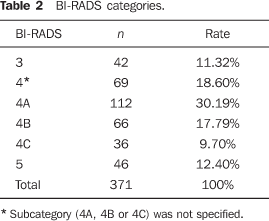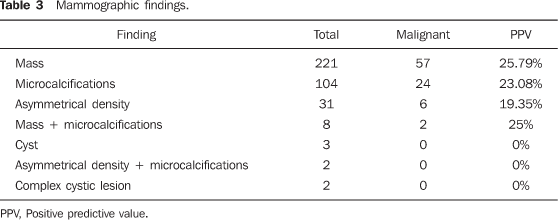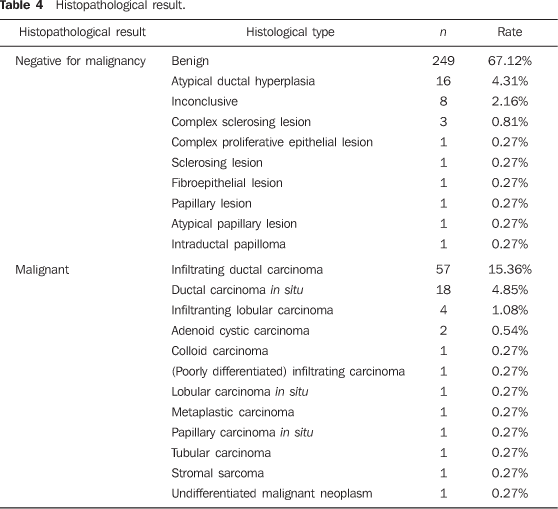Radiologia Brasileira - Publicação Científica Oficial do Colégio Brasileiro de Radiologia
AMB - Associação Médica Brasileira CNA - Comissão Nacional de Acreditação
 Vol. 43 nº 3 - May / June of 2010
Vol. 43 nº 3 - May / June of 2010
|
ORIGINAL ARTICLE
|
|
Positive predictive value of Breast Imaging Reporting and Data System (BI-RADS®) categories 3, 4 and 5 |
|
|
Autho(rs): Gérson Luís Medina Prado, Maria Tereza Paraguassú Martins Guerra |
|
|
Keywords: BI-RADS, Mammography, Cancer, Breast |
|
|
Abstract:
IPhD, MD, Radiologist, Substitute Professor at Faculdade de Ciências Médicas da Universidade Estadual do Piauí (UESPI), Teresina, PI, Brazil
INTRODUCTION Breast cancer is the second most frequent type of tumor worldwide and the first one among women, with more than 10 million new cases and more than 6 million deaths per year(1). In Brazil, breast cancer is prevalent in women aged between 40 and 69 years, and is the leading cause of female deaths(2). According to the Estimates of Cancer Incidence in Brazil for 2010, published by Instituto Nacional de Câncer (INCA), the number of new breast cancer cases expected for the country in 2010 corresponds to 49,240, with an estimated risk of 49 cases for every 100,000 women(3). The reporting standardization developed in 1993 by the American College of Radiology (ACR) - Breast Imaging Reporting and Data System (BI-RADS®), currently in its fourth edition -, is an attempt to standardize the reading and reporting of mammographic images, improving the communication among the different health professionals involved in the diagnosis and treatment of breast cancer, aiding in the investigation and follow-up of patients(4). According to the fourth edition of BI-RADS(5), the classification of mammo-grams is based on the level of suspicion of the lesion as follows: category 1 (negative); category 2 (benign findings); category 3 (probably benign findings); category 4 (findings suspicious for malignancy); category 5 (findings highly suggestive of malignancy). Lesions requiring further evaluation with, for example, ultrasonography, are classified as category 0, and those with a previously confirmed malignant histopathological diagnosis, as category 6. Category 4 has been subdivided into 4A, 4B and 4C. All the categories must reflect the radiologist's level of suspicion for malignancy and correspond exactly to the possibility of malignancy confirmed by subsequent studies such as plain mammography, mammography with supplementary views, ultrasonography with or without Doppler, and magnetic resonance imaging(4,6,7). The present study was aimed at evaluating BI-RADS categories 3, 4 and 5 as positive predictive value for malignancy of non-palpable breast lesions, correlating mammographic and histopathological findings, at the division of radiology of a center of reference in cancer treatment in Teresina, PI, Brazil. Such comparison was based on the calculation of the positive predictive value (PPV) of mammographic images.
MATERIALS AND METHODS All the patients referred to the division of radiology of a center of reference in cancer treatment to be submitted to invasive procedures for histopathological investigation of breast lesions classified as BI-RADS categories 3, 4 and 5, in the period from July 2005 to March 2008, had their mammograms reviewed independently of the origin of such studies. Patients with mammograms classified as BI-RADS 0, 1, 2, 6, or with incomplete mammographic reports (without type and size of findings), were excluded. The following data were collected: patients' origin and age, site of the finding (right/left breast and quadrant), type of finding and respective BI-RADS category. Among the patients, 265 underwent core biopsy with 12-14 gauge needle guided either by digital stereotaxy (Mammomat 3000 Nova/Opdima - Siemens; Erlangen, Germany) or ultrasonography (Logiq 7 - General Electric Medical Systems; Milwaukee, WI, USA), and 106 were submitted to preoperative needle localization either by digital stereotaxy (Mammomat 3000 Nova/Opdima) or ultrasonography (Logiq 7). All the above mentioned procedures were performed by a single radiologist, Board Certified by the Colégio Brasileiro de Radiologia e Diagnóstico por Imagem (CBR). Data regarding the histological analyses were also collected. The PPVs were calculated and the final results were compared with available data in the literature.
RESULTS Data regarding 426 invasive procedures were collected. Among them 371 matched the inclusion criteria. Most of the patients (73.85%) lived in the state of Piauí. The patients' age range was from 23 to 89 years - mean age, 52.49 years (51.31 years among those with benign histopathological results, and 56.21 years among those with malignant results). Table 1 demonstrates the correlation between age and risk for breast cancer.
The majority of the procedures (208 of 371) were performed in the right breast and in three patients both breasts were involved. The distribution according to affected quadrant demonstrated a highest incidence on the lateral upper quadrant (171 mammograms). Ten mammograms presented findings on two quadrants, and one, in three quadrants. Thus, on 371 mammograms, 383 quadrants were affected. The distribution according to BI-RADS, demonstrated a predominance of category 4 findings (Table 2).
Masses, microcalcifications, cystic lesions and asymmetric densities were mentioned as indications for submission to invasive procedures (Table 3).
The majority of the invasive procedures (71.43%) were performed by means of core biopsy, and preoperative needle localization was performed in 28.57% of the procedures. Histological studies demonstrated the following results: 76% negative for malignancy and 24% positive for malignancy (Table 4).
Positive predictive values for categories 3, 4 and 5 were, respectively, 7.14%, 16.96% and 82.61% (Table 5).
In the calculation of the PPV for the category 4 subcategories, the 69 studies whose reports failed to indicate the subcategory were not taken into consideration (Table 6).
The PPVs were separately calculated for core biopsies and preoperative needle localization (Tables 7 and 8).
DISCUSSION Since the appearance of the BI-RADS, in 1993, numberless studies have been developed with the objective of correlating imaging findings with histopathological findings(4). In the present study, the right breast was most affected in 56.06% of cases, and so did the lateral upper quadrant (171 in 383 affected quadrants). The presence of a mass was most frequent for invasive procedures (59.57% of cases). In the present study, the first most frequent type of cancer was infiltrating ductal carcinoma (15.36% of cases), the second, ductal carcinoma in situ (4.85% of cases). The mean age of patients with cancer was higher than the mean age of patients with benign lesions, and Table 1 demonstrates, through the relative risk and odds ratio, that advanced age is a risk factor for the disease. The BI-RADS suggests values < 2% chance of malignancy for category 3, and > 95% for category 5. Category 4 must indicate 23%-30% chance of malignancy(5). In the present study, 23.99% of patients submitted to histopathological study presented malignant lesions, i.e., the global PPV was of 23,99%. In the USA, this value ranges between 15% and 40%(8-10). In the present study, 42 patients presented probably benign findings (BI-RADS 3), three presented positive results for malignancy; thus the PPV remained above the recommended rate (7.14% > 2%), which is within the mean rate reported by studies in the literature where this rate ranges between 0% and 8%. For category 4, the authors found a PPV of 16.96%, while in the literature this rate ranges between 4% and 63%. The PPV was separately calculated for subcategories 4A (8.04%), 4B (15.15%) and 4C (41.67%). The PPV of 82.61% for category 5 is within the expected range as compared with the several studies in the literature which report this parameter ranging between 54% and 100%(11-22). The above mentioned values reflect the correlation between mammographic findings and results of two types of invasive procedures, namely, core biopsy and preoperative needle localization. Once values are separately calculated for each type of invasive procedure, even lower PPVs are found for the cases submitted to core biopsy, as follows: for category 3, 7.14% (0% to 4% in the literature); for category 4, 15.76% (4% to 20% in the literature); and for category 5, 76.47% (54% to 92% in the literature)(13,14,18-21). As only the cases submitted to preoperative needle localization were taken into consideration, the following values were found: 7.14% for category 3 (0% to 5% in the literature); 20% for category 4 (26% to 34% in the literature); and 100% for category 5 (81% to 97% in the literature)(12,13,16,17). The difference between PPVs for core biopsies and for preoperative needle localization corroborate the values reported in the literature which demonstrate that the PPV for mammography is higher as the finding is submitted to preoperative needle localization. Among the lesions diagnosed as atypical ductal hyperplasias at 14 gauge needle core biopsy, 20% to 56% correspond to carcinomas at surgical biopsy(23). It should be taken into consideration that the BI-RADS may present limitations related to the classification itself and the training of radiologists involved in the utilization of this system(24,25).
CONCLUSION The present study demonstrated discrepancies between the BI-RADS classification and histopathological results for findings in patients submitted to invasive diagnostic procedures at a center of reference for cancer treatment in Teresina, PI, which, in some cases demonstrated to be unnecessary, particularly for findings classified as BI-RADS 4 and 5. Additionally, underestimation of findings classified as BI-RADS 3 was observed.
REFERENCES 1. National Cancer Institute. Surveillance, Epidemiology and End Results (SEER). [acessado em 16 de maio de 2008]. Disponível em: http://seer.cancer.gov [ ] 2. Ministério da Saúde. Instituto Nacional de Câncer. Estimativa 2006: incidência de câncer no Brasil. [acessado em 16 de maio de 2008]. Disponível em: http://www.inca.gov.br/estimativa/2006 [ ] 3. Ministério da Saúde. Instituto Nacional de Câncer. Estimativa 2009: incidência de câncer no Brasil. [acessado em 7 de dezembro de 2009]. Disponível em: http://www.inca.gov.br/estimativa/2010 [ ] 4. American College of Radiology. The ACR breast imaging reporting and data system (BI-RADS) [web source]. November 11, 2003. [cited 2004 Feb 27]. Available from: http://www.acr.org/departments/stand_accred/birads/contents.html [ ] 5. American College of Radiology. Breast Imaging Reporting and Data System (BI-RADS®). 4th ed. Reston, VA: American College of Radiology; 2003. [ ] 6. Nascimento JHR, Silva VD, Maciel AC. Acurácia dos achados ultrassonográficos do câncer de mama: correlação da classificação BI-RADS® e achados histológicos. Radiol Bras. 2009;42:235-40. [ ] 7. Schmillevitch J, Guimarães Filho HA, De Nicola H, et al. Utilização do índice de resistência vascular na diferenciação entre nódulos mamários benignos e malignos. Radiol Bras. 2009;42:241-4. [ ] 8. Ciatto S, Cataliotti L, Distante V. Nonpalpable lesions detected with mammography: review of 512 consecutive cases. Radiology. 1987;165:99-102. [ ] 9. Cyrlak D. Induced costs of low-cost screening mammography. Radiology. 1988;168:661-3. [ ] 10. Hall FM, Storella JM, Silverstone DZ, et al. Nonpalpable breast lesions: recommendations for biopsy based on suspicion of carcinoma at mammography. Radiology. 1988;167:353-8. [ ] 11. Lacquement MA, Mitchell D, Hollingsworth AB. Positive predictive value of the Breast Imaging Reporting and Data System. J Am Coll Surg. 1999;189:34-40. [ ] 12. Orel SG, Kay N, Reynolds C, et al. BI-RADS categorization as a predictor of malignancy. Radiology. 1999;211:845-50. [ ] 13. Liberman L, Abramson AF, Squires FB, et al. The breast imaging reporting and data system: positive predictive value of mammographic features and final assessment categories. AJR Am J Roentgenol. 1998;171:35-40. [ ] 14. Bérubé M, Curpen B, Ugolini P, et al. Level of suspicion of a mammographic lesion: use of features defined by BI-RADS lexicon and correlation with large-core breast biopsy. Can Assoc Radiol J. 1998;49:223-8. [ ] 15. Kestelman FP, Canella EO, Arvellos NA, et al. Classificação radiológica nas lesões não-palpáveis da mama. Análise de resultados do Hospital do Câncer III - INCA-MS. Radiol Bras. 2001;34 (Supl 1):20. [ ] 16. Ball CG, Butchart M, MacFarlane JK. Effect on biopsy technique of the breast imaging reporting and data system (BI-RADS) for nonpalpable mammographic abnormalities. Can J Surg. 2002; 45:259-63. [ ] 17. Tan YY, Wee SB, Tan MP, et al. Positive predictive value of BI-RADS categorization in an Asian population. Asian J Surg. 2004;27:186-91. [ ] 18. Tate PS, Rogers EL, McGee EM, et al. Stereotactic breast biopsy: a six-year surgical experience. J Ky Med Assoc. 2001;99:98-103. [ ] 19. Margolin FR, Leung JW, Jacobs RP, et al. Percutaneous imaging-guided core breast biopsy: 5 years' experience in a community hospital. AJR Am J Roentgenol. 2001;177:559-64. [ ] 20. Travade A, Isnard A, Bagard C, et al. Macro-biopsies stéréotaxiques par système à aspiration 11-G: à propos de 249 patientes. J Radiol. 2002; 83(9 Pt 1):1063-71. [ ] 21. Mendez A, Cabanillas F, Echenique M, et al. Mammographic features and correlation with biopsy findings using 11-gauge stereotactic vacuum-assisted breast biopsy (SVABB). Ann Oncol. 2004;15:450-4. [ ] 22. Zonderland HM, Pope TL Jr, Nieborg AJ. The positive predictive value of the breast imaging reporting and data system (BI-RADS) as a method of quality assessment in breast imaging in a hospital population. Eur Radiol. 2004;14: 1743-50. [ ] 23. Liberman L. Percutaneous image-guided core breast biopsy. Radiol Clin North Am. 2002;40:483-500. [ ] 24. Liberman L, Menell JH. Breast imaging reporting and data system (BI-RADS). Radiol Clin North Am. 2002;40:409-30. [ ] 25. Godinho ER, Koch HA. Breast Imaging Reporting and Data System (BI-RADS™): como tem sido utilizado? Radiol Bras. 2004;37:413-7. [ ]
Received December 8, 2009.
* Study developed at the Unit of Radiology of São Marcos Hospital - Universidade Estadual do Piauí (UESPI), Teresina, PI, Brazil. |
|
Av. Paulista, 37 - 7° andar - Conj. 71 - CEP 01311-902 - São Paulo - SP - Brazil - Phone: (11) 3372-4544 - Fax: (11) 3372-4554








